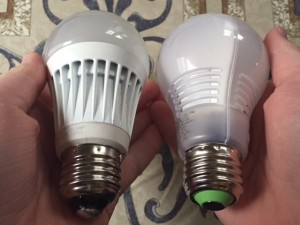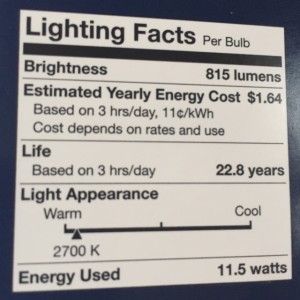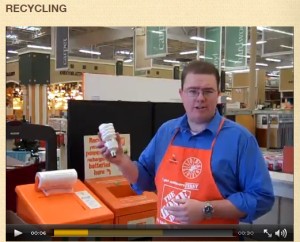Blinded by the (LED) light.
I have been struggling to pick a topic from one of the several items that always seem to be running through my head and across my work desk at any moment in time. Enter Maarten, my husband, with a new LED bulb for our sconce lights in our living room.
Wow.

Old-er LED on left
I grabbed the new LED and the old LED bulbs and was stunned at the changes in just one year! The new one is about half the weight of the old. They both still are replacement screw in bulbs, they both use LED with the typical drivers, and they both mimic the shape of a “traditional” incandescent. Other than that they are vastly different. The old bulb (old-er, really, as it’s only a year “old” and just a small part through its life use) has a heavy heat sink that takes up about half the bulb length. It is an entirely closed “bulb” and it uses 8 watts to produce 430 lumens. The new one has no visible heat sink as the LED are placed on small separate fins along the center core of the bulb. The bulb housing is plastic and highly vented at the top as well as the lower sides. It uses 11.5 watts, which includes networking capability to dim and switch the bulb with a smart home control system, to produce 815 lumens. All that advancement in just one year!
Think of what this means regarding energy efficiency, use of materials and engagement of users. Energy efficiency is pretty obvious, and the easy part of the development – more lumens per watt and an ability to control the bulb output with a home automation system such as Smart Things. Control nearly always leads to savings.
The most significant improvement is in material use. Aluminum, often used in heat sinks for LED, is one of the most burdensome materials regarding “attributed carbon” due to its mining and processing, even though aluminum is a highly recycled material. The short history of LED has focused on integral heat sinks, and very few, if any, manufacturers have made modular products where the heat sink can be taken off and re-used directly or easily recycled. LED is a long-lived bulb or fixture, and attention to the modularization of that system has not occurred market-wide. This is a huge failure in the world of LED. Reducing the weight of the heat sink (the new bulb is less than 1/2 the weight of the old) or eliminating it completely by clever, open airflow design of the bulb casing is likely to be a real environmental game-changer. And there are clear sustainable benefits to solid state technology. An LED bulb will emit about 15 lbs of CO2-e a year while a CFL will emit 35 lbs and an incandescent will emit 150 lbs (shocker)! And LED bulbs do not include mercury.
Finally, the control system and ability to dim the light help people understand and engage in their own energy use systems. The capabilities at the level of app-run control or automation systems include setting day/night ranges, dimming for varied use of the space (we dim down to 10% or so when we watch movies) and, most powerfully, referencing on-line weather and time sites to react to predictive or real time exterior lighting parameters. This is engagement at a whole new level, well beyond merely switching a light on or off.
Huh, all that in a simple replacement bulb. We’re down to about 300 days to “change a light bulb” and that timeframe will likely half for each pending generation of replacement LED (or other innovative lighting), just as it does in any advancing technology. Does this mean you should wait to install LED replacement bulbs? Absolutely not. Especially now that the quality is exceptional, the bulbs themselves are lighter and less material intensive, there is no mercury content, the price is lower than ever and they now can include network connectivity. Be momentarily blinded by the light of opportunity, and install the current generation of LED bulbs! Of course, you should recycle any CFLs responsibly by bringing them to Home Depot or another local company that will process them with care (see link below). When the next-gen of LED comes around you should take a little time to decide if you’re ready to upgrade again. Rest assured you’ll be free to donate your “old” LEDs to your local community theatre, church or school knowing there is no harm in that bulb.
Let there be light!
Resources:
http://www.ecooptions.homedepot.com/healthy-home/recycling/
Be the first to like this post (no login required)



Pingback: LED Curtains
Thanks Jodi!